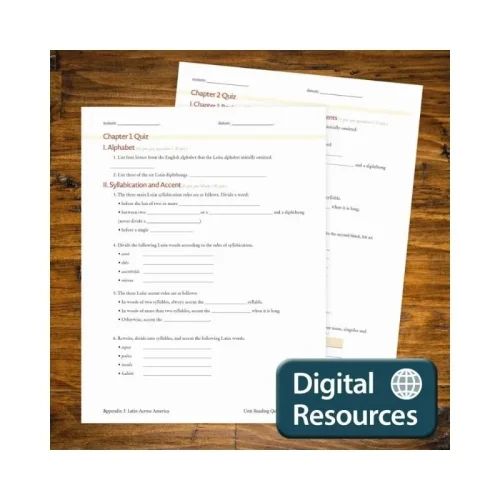Description
68 tear-out pages. May be copied and used as needed.
This workbook provides supplementary practice on selected lessons. The teacher’s manual tells when and how to use the workbook. The answer key is in the teacher’s manual.
English 5 has 119 lessons divided into 10 chapters. The first two chapters deal with understanding sentence types and structure. Chapters 3-7 and chapter 9 focus on the eight parts of speech. Chapter 8 teaches concepts about punctuation. Chapter 10 deals with miscellaneous lessons on capitalization, the dictionary, synonyms, antonyms, Bible reference books, hyphens, and colons. Interspersed throughout the book are 28 composition lessons. Continual review is built into the course.
The worksheets booklet contains 68 sheets that may be copied as needed in teaching this English course. The test booklet contains 10 chapter tests.
The teacher’s manual has reduced copies of the pupil’s text, with the answer keys beside the exercises. For the worksheets and tests, the answers are shown in color on the reproduced pupil’s pages. Guidance is given for presenting the lesson to the students. The specific points to be taught are listed, along with further instruction and information for the teacher.
Table of Contents
(Bold indicates composition and oral English lessons.)
Chapter 1 – Working With Sentences
- 1. Introduction
- 2. Complete Sentences
- 3. The Predicate of a Sentence
- 4. The Subject of a Sentence
- 5. Writing About a Personal Experience
- 6. Statements and Questions
- 7. Commands and Exclamations
- 8. Diagraming Sentence Skeletons
- 9. Using Exact Words
- 10. Chapter 1 Review
Chapter 2 – More About Sentences
- 11. The Paragraph
- 12. Compound Subjects and Predicates
- 13. More Compound Subjects and Predicates
- 14. Compound Sentences
- 15. Writing Paragraphs With Unity and Order
- 16. Simple Sentences and Compound Sentences
- 17. Avoiding Comma Splices and Run-on Sentences
- 18. Combining Choppy Sentences
- 19. Sentence Variety in Paragraphs
- 20. Sentences That Begin With There Is or There Are
- 21. Chapter 2 Review
Chapter 3 – Nouns
- 22. Nouns
- 23. Common and Proper Nouns
- 24. Singular and Plural Nouns
- 25. Developing Paragraphs by Giving Examples
- 26. More Plural Nouns
- 27. Possessive Nouns
- 28. Appositives and Nouns of Direct Address
- 29. Developing Paragraphs by Using Steps
- 30. Chapter 3 Review
Chapter 4 – Verbs
- 31. Verbs
- 32. The Verb Be
- 33. Helping Verbs and Verb Phrases
- 34. Learning to Outline
- 35. Agreement of Subjects and Verbs
- 36. Using Forms of Be and Do
- 37. Verb Tense
- 38. More About Outlining
- 39. The Principal Parts of Verbs
- 40. Principal Parts of Irregular Verbs
- 41. Using Verb Forms Correctly
- 42. Giving Directions Orally
- 43. Chapter 4 Review
Chapter 5 – More About Verbs
- 44. Sentences With Direct Objects
- 45. Sentences With Compound Direct Objects
- 46. Principal Parts of Common Irregular Verbs
- 47. Observing, Listening, and Taking Notes
- 48. Using Raise and Rise
- 49. Using Set and Sit
- 50. Using Lay and Lie
- 51. Using Let and Leave
- 52. Making an Outline for a Report
- 53. Linking Verbs
- 54. Linking Verbs With Predicate Nouns
- 55. Linking Verbs With Predicate Adjectives
- 56. Writing a Report
- 57. More Troublesome Verbs
- 58. Chapter 5 Review
Chapter 6 – Pronouns
- 59. Pronouns Stand for Nouns
- 60. Nominative Case Pronouns
- 61. Objective Case Pronouns
- 62. The Form of a Friendly Letter
- 63. Possessive Case Pronouns
- 64. Nominative, Objective, and Possessive Pronouns
- 65. Demonstrative Pronouns
- 66. Writing an Interesting Friendly Letter
- 67. Indefinite Pronouns
- 68. Interrogative Pronouns
- 69. Addressing an Envelope
- 70. Chapter 6 Review
Chapter 7 – Adjectives and Adverbs
- 71. What Are Adjectives?
- 72. Limiting Adjectives
- 73. Predicate Adjectives
- 74. Poetry
- 75. Appositive Adjectives
- 76. Adjectives That Compare
- 77. What Are Adverbs?
- 78. Rhyme and Rhythm in Poetry
- 79. Modifiers of Adjectives and Adverbs
- 80. More Practice With Adjectives and Adverbs
- 81. Adverbs That Compare
- 82. More About Rhythm in Poetry
- 83. Descriptive Language in Poetry
- 84. Using Good, Well, and Negative Words
- 85. Chapter 7 Review
Chapter 8 – Punctuation
- 86. Punctuating Sentences and Abbreviations
- 87. Using Commas Correctly
- 88. More About Commas
- 89. Telling a Story About a Personal Experience
- 90. Using Apostrophes Correctly
- 91. Direct and Indirect Quotations
- 92. More About Direct Quotations
- 93. Writing a Book Report
- 94. Divided Quotations
- 95. Writing Conversation
- 96. Chapter 8 Review
Chapter 9 – Prepositions, Conjunctions, and Interjections
- 97. Writing a Story
- 98. Prepositions
- 99. Prepositional Phrases Used as Adjectives
- 100. Prepositional Phrases Used as Adverbs
- 101. Using Conversation to Make Stories Interesting
- 102. Prepositions and Adverbs
- 103. Using Prepositions Correctly
- 104. Conjunctions
- 105. Writing a Good Title
- 106. Interjections
- 107. Chapter 9 Review
Chapter 10 – Capitalization, Reference Books, and More Punctuation
- 108. Capitalization
- 109. Capitalizing Names and Titles
- 110. Using Our Senses in Writing Descriptions
- 111. Using the Dictionary
- 112. Pronunciation and Meaning
- 113. Synonyms and Antonyms
- 114. Making Introductions
- 115. Homonyms
- 116. Using a Concordance and a Bible Dictionary
- 117. Using Hyphens and Colons
- 118. Using the Telephone
- 119. Chapter 10 Review
Worksheets
Chapter 1
- 1. Review of Action Verbs (Lesson 1)
- 2. Review of Helping Verbs and Verb Phrases (Lesson 1)
- 3. Complete Sentences (Lesson 2)
- 4. The Predicate of a Sentence (Lesson 3)
- 5. The Subject of a Sentence (Lesson 4)
- 6. Sentence Types (Lesson 7)
- 7. Diagraming the Four Sentence Types (Lesson 8)
Chapter 2
- 8. The Paragraph (Lesson 11)
- 9. Compound Subjects and Predicates (Lesson 13)
- 10. Writing Paragraphs With Unity and Order (Lesson 15)
- 11. Simple Sentences and Compound Sentences (Lesson 16)
- 12. Comma Splices and Run-on Sentences (Lesson 17)
- 13. Sentences That Begin With There Is or There Are (Lesson 20)
Chapter 3
- 14. Nouns (Lesson 22)
- 15. Common and Proper Nouns (Lesson 23)
- 16. Possessive Nouns (Lesson 27)
- 17. Appositives and Nouns of Direct Address (Lesson 28)
- 18. Working With Paragraphs (Lesson 29)
Chapter 4
- 19. Action Verbs (Lesson 31)
- 20. The Verb Be (Lesson 32)
- 21. Helping Verbs and Verb Phrases (Lesson 33)
- 22. Learning to Outline (Lesson 34)
- 23. Diagraming Review (Lesson 37)
- 24. More About Outlining (Lesson 38)
- 25. Using Verb Forms Correctly (Lesson 41)
Chapter 5
- 26. Diagraming Sentences That Have Direct Objects (Lesson 45)
- 27. Raise-Rise and Set-Sit (Lesson 49)
- 28. Lay-Lie and Let-Leave (Lesson 51)
- 29. Linking Verbs (Lesson 53)
- 30. Diagraming Sentences That Have Direct Objects, Predicate Nouns, and Predicate Adjectives (Lesson 55)
Chapter 6
- 31. Pronouns (Lesson 59)
- 32. Nominative Case Pronouns (Lesson 60)
- 33. Objective Case Pronouns (Lesson 61)
- 34. Practice With the Friendly Letter (Lesson 62)
- 35. Review of Pronouns (Lesson 64)
- 36. Demonstrative and Indefinite Pronouns (Lesson 67)
- 37. Demonstrative, Indefinite, and Interrogative Pronouns (Lesson 68)
- 38. Writing a Friendly Letter and Addressing an Envelope (Lesson 69)
Chapter 7
- 39. Working With Adjectives (Lesson 72)
- 40. Diagraming Adjectives (Lesson 73)
- 41. Adjectives That Compare (Lesson 76)
- 42. Adverbs (Lesson 79)
- 43. Diagraming Adjectives and Adverbs (Lesson 80)
- 44. Adverbs That Compare (Lesson 81)
- 45. Rhyme and Rhythm in Poetry (Lesson 82)
- 46. Descriptive Language in Poetry (Lesson 83)
- 47. Using Good, Well, and Negative Words (Lesson 84)
Chapter 8
- 48. Punctuating Sentences and Abbreviations (Lesson 86)
- 49. Using Commas (Lesson 88)
- 50. Using Apostrophes (Lesson 90)
- 51. Direct Quotations (Lesson 94)
- 52. Writing Conversation (Lesson 95)
Chapter 9
- 53. Prepositions (Lesson 98)
- 54. Adjective and Adverb Phrases (Lesson 100)
- 55. Prepositions and Adverbs (Lesson 102)
- 56. Using Prepositions Correctly (Lesson 103)
- 57. Conjunctions (Lesson 104)
- 58. Conjunctions and Interjections (Lesson 106)
- 59. Parts of Speech Review (Lesson 106)
Chapter 10
- 60. Capitalization Review (Lesson 109)
- 61. Dictionary Skills (Lesson 111)
- 62. Pronunciation and Meaning in the Dictionary (Lesson 112)
- 63. Synonyms, Antonyms, and Homonyms (Lesson 115)
- 64. Diagraming Review (Lesson 116)
- 65. More Diagraming Review (Lesson 116)
- 66. Hyphens and Colons (Lesson 117)
- 67. Parts of Speech Review (Lesson 118)
- 68. Poetry and Capitalization Review (Lesson 118)
Companion Products
Rod and Staff Grade 5 English Textbook: Following the Plan
Rod and Staff Grade 5 English Teacher’s Manual: Following the Plan
Rod and Staff Grade 5 English Tests: Following the Plan
Rod and Staff Grade 5 English Set: Following the Plan


















Reviews
There are no reviews yet.